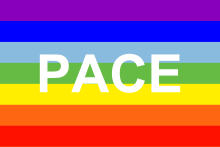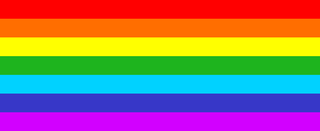
There have been several designs for a peace flag.

There have been several designs for a peace flag.

The white flag is recognized in most of the world as a flag of surrender, truce or ceasefire. The first mention of a white flag used in this context is made during the Eastern Han dynasty (AD 25–220). A white flag was also used by the anti-war movement during the US Civil War in 1861. [1] [2]
In 1891, the third Universal Peace Congress in Rome devised a generalized Peace Flag design, which was simply the home nation's flag bordered in white to signify non-violent conflict resolution. This was used (although not officially adopted) by the American Peace Society [3] and the Universal Peace Union. [4] It was designed by Henry Pettit. [5]


In the 1890s, expatriate American Cora Slocomb di Brazza Savorgnan, the Countess Di Brazzà, invented a universal peace flag with three upright bands: yellow, purple, and white, which became the peace flag of the International Peace Bureau. [6] Originally, there was a complicated symbol on the middle band: "a shield ... surmounted by a man's and a woman's clasped hands, sustained by a pair of dove wings with a white star aloft; on the shield can appear any device chosen by the association adopting the flag, or simply the number of enrollment among the users of the flag, or the motto Pro Concordia Labor (For Peace I Work), or this motto may be placed upon a ribbon on the flag beneath the shield, or on a streamer (white) from the flag staff (blue, the color of promise) surmounted by a star with the motto of the association or individual using the flag upon the other white streamer". [7]
This flag was adopted by the International Council of Women in 1896. In 1904, it lost the complicated design and became a simple tricolor. [8]

James William van Kirk , a Methodist minister from Youngstown, Ohio designed the first world peace flag of the Earth, using rainbow stripes, stars and a globe. In 1913 and 1929, he made a peace tour through Europe with his flag. [9] He traveled around the world arguing for "the brotherhood of man and the Fatherhood of God". [10]
The Universal Peace Congress eventually came to adopt Kirk's flag as its official World Peace Flag, and it was subsequently adopted by the American Peace Society as well as other groups. It consisted of "the earth on a blue field covered with white stars; a white band crossed the globe and to the left was broken up into a spectrum representing the variations of the human race—different, but united in peace". [11] The flag also shows 46 stars surrounding the globe and the spectrum.
In 1938, Kirk authored an autobiography, Stranger than fiction: four times around the world, designer of world flag, a world builder, at 80 years makes a new start in life.

The banner of peace is a symbol of the Roerich Pact. This pact was the first international treaty dedicated to the protection of artistic and scientific institutions and historical monuments. [12] It was signed on 15 April 1935. The banner of peace was proposed by Nicholas Roerich for an international pact for the protection of culture values.
The examples and perspective in this section deal primarily with Italy and do not represent a worldwide view of the subject.(March 2023) |

The most common recent design is a rainbow flag representing peace, first used in Italy at a peace march in 1961. The flag was inspired by similar multi-coloured flags used in demonstrations against nuclear weapons. A previous version had featured a dove drawn by Pablo Picasso. [13]
The most common variety has seven colours—purple, blue, azure, green, yellow, orange, and red—and is emblazoned in bold with the Italian word PACE, meaning "peace".
It became popular with the Pace da tutti i balconi ("peace from every balcony") campaign in 2002, started as a protest against the impending invasion of Iraq. At that time its use was met with criticism from the Italian LGBT community for being too similar to the LGBT six-color gay pride flag (which was originally created in San Francisco California in 1979 and had started being used regularly in Italy a couple of years earlier during the 2000 inaugural WorldPride celebration in Rome). [14] The flag was flown from balconies in all Italian cities by citizens against the war. Its use spread to other countries too, and the Italian Pace was sometimes, but not everywhere, replaced with the corresponding translation in the local languages.
According to Amnesty International, producer Franco Belsito had produced about 1,000 flags per year for 18 years, and suddenly had to cope with a demand in the range of the millions. [15]
Common variations include moving the purple stripe down below the azure one, and adding a white stripe on top.
The seven-color peace flag is not to be confused with the similar six-color gay pride flag, which does not have azure and has the colors in the opposite order with red at the top.
"The Peace Flag" is an initiative that aims to unify all nations underneath one common symbol on International Peace Day. While there are various icons of peace – the olive branch, the dove – there is no official world flag of peace adopted by the United Nations. This initiative proposes that, for one day a year on 21 September, every country raises an all-white version of their national flag to represent that we are all one. In 2013, embassies of Colombia, Equatorial Guinea and Ecuador in London officially agreed to support The Peace Flag initiative by raising a colorless version of their respective flags on 21 September. The initiative was nominated for a White Pencil in 2012 at D&AD for its contribution towards peace, in support of Peace One Day.[ citation needed ]

The first large peace flag was made in Lecce, Salento, Italy by the association "GPace - Youth for peace" on Saturday, 14 November 2009. It was 21 m × 40 m (70 by 130 feet). Three years later this record was broken. On 21 September 2012, the Belgian Peace Organisation [16] (30 m × 50 m/100 by 165 feet) in the historic center of Ghent. The action aimed to reinforce the demand to disarm in order to make room for sustainable development.

A rainbow flag is a multicolored flag consisting of the colors of the rainbow. The designs differ, but many of the colors are based on the seven spectral colors of the visible light spectrum.

The flag of San Marino is formed by two equal horizontal bands of white (top) and light blue with the national coat of arms superimposed in the center; the coat of arms has a shield with a closed crown on top, flanked by an oak and laurel wreath, with a scroll below bearing the word LIBERTAS (Freedom). The two colors of the flag represent peace (white) and liberty.

The flag of Vatican City was adopted in 1929. 1929 is the year Pope Pius XI signed the Lateran Treaty with Italy, creating a new independent state governed by the Holy See. The flag of Vatican City is modeled on the 1808 yellow-and-white flag of the earlier Papal States, to which a papal tiara and the crossed keys of Saint Peter were added.
The Treaty on the Protection of Artistic and Scientific Institutions and Historic Monuments or Roerich Pact is an inter-American treaty. The most important idea of the Roerich Pact is the legal recognition that the defense of cultural objects is more important than the use or destruction of that culture for military purposes, and the protection of culture always has precedence over any military necessity.

A number of peace symbols have been used many ways in various cultures and contexts. The dove and olive branch was used symbolically by early Christians and then eventually became a secular peace symbol, popularized by a Dove lithograph by Pablo Picasso after World War II. In the 1950s the "peace sign", as it is known today, was designed by Gerald Holtom as the logo for the British Campaign for Nuclear Disarmament (CND), a group at the forefront of the peace movement in the UK, and adopted by anti-war and counterculture activists in the US and elsewhere. The symbol is a superposition of the semaphore signals for the letters "N" and "D", taken to stand for "nuclear disarmament", while simultaneously acting as a reference to Goya's The Third of May 1808 (1814).

The national flag of Italy, often referred to in Italian as il Tricolore, is a tricolour featuring three equally sized vertical pales of green, white and red, national colours of Italy, with the green at the hoist side, as defined by article 12 of the Constitution of the Italian Republic. The Italian law regulates its use and display, protecting its defense and providing for the crime of insulting it; it also prescribes its teaching in Italian schools together with other national symbols of Italy.

The national flag of Uzbekistan consists of a horizontal triband of azure, white and green, separated by two thin red fimbriations, with a white crescent moon and twelve white stars at the canton. Adopted in 1991 to replace the flag of the Uzbek Soviet Socialist Republic (SSR), it has been the flag of the Republic of Uzbekistan since the country gained independence in that same year. The design of the present flag was partly inspired by the former one.

The Senyera is a vexillological symbol based on the coat of arms of the Crown of Aragon, which consists of four red stripes on a yellow field. This coat of arms, often called bars of Aragon, or simply "the four bars", historically represented the King of the Crown of Aragon.

The Royal Banner of the Royal Arms of Scotland, also known as the Royal Banner of Scotland, or more commonly the Lion Rampant of Scotland, and historically as the Royal Standard of Scotland, or Banner of the King of Scots, is the royal banner of Scotland, and historically, the royal standard of the Kingdom of Scotland. Used historically by the Scottish monarchs, the banner differs from Scotland's national flag, the Saltire, in that its official use is restricted by an Act of the Parliament of Scotland to only a few Great Officers of State who officially represent the Monarchy in Scotland. It is also used in an official capacity at royal residences in Scotland when the Head of State is not present.

The flag of Friuli is the official standard of historical Friuli. A Friuli-Venezia Giulia Autonomous Regional law describes the flag as consisting of "…a rectangular standard featuring at its centre a golden heraldic eagle with outspread wings, headturned to the left, open beak and red claws, set in a sky blue field. The crest covers three fifths of the height of the flag, which in turn is two thirds of its length."

The emblem of the Italian Republic was formally adopted by the newly formed Italian Republic on 5 May 1948. Although often referred to as a coat of arms, it is an emblem as it was not designed to conform to traditional heraldic rules. The emblem is used extensively by the Italian government.

The Flags of Napoleonic Italy were the green, white and red tricolour flags and banners in use in Italy during the Napoleonic era, which lasted from 1796 to 1814. During this period, on 7 January 1797, the green, white and red tricolour was officially adopted for the first time as a national flag by a sovereign Italian state, the Cispadane Republic. This event is commemorated by the Tricolour Day.

The coat of arms of the Azores is nine gold stars superimposed on a red bordure, representing the nine islands of the archipelago. The bordure surrounds a silver shield on which a blue goshawk is displayed with wings elevated and with red feet, beak, and tongue. The crest is a closed helm in gold lined with red, surmounted by a wreath and mantling of silver and blue, topped by another blue eagle on which are superimposed the same nine gold stars.

The banner of peace is a symbol of the Roerich Pact. This pact is the first international treaty dedicated to the protection of artistic and scientific institutions and historical monuments. It was signed on April 15, 1935. The banner of peace was proposed by Nicholas Roerich for an international pact for the protection of culture values.
National symbols of Italy are the symbols that uniquely identify Italy reflecting its history and culture. They are used to represent the Nation through emblems, metaphors, personifications, allegories, which are shared by the entire Italian people.

The national colours of Italy are green, white, and red, collectively known in Italian as il Tricolore. The three Italian national colours appeared for the first time in Genoa on 21 August 1789 on the cockade of Italy shortly after the outbreak of the French Revolution, on 11 October 1796 they were used for the first time in Milan on a military banner, while on 7 January 1797 in Reggio Emilia they appeared for the first time on a flag.

Tricolour Day, officially National Flag Day, is the flag day of Italy. Celebrated on 7 January, it was established by Law 671 on 31 December 1996. It is intended as a celebration, though not a public holiday. The official celebration of the day is held in Reggio Emilia, the city where the Italian tricolour was first adopted as flag by an Italian sovereign state, the Cispadane Republic, on 7 January 1797.

The Flag of the Republic of Venice, commonly known as the Banner or Standard of Saint Mark, was the symbol of the Republic of Venice, until its dissolution in 1797.

The cockade of Italy is the national ornament of Italy, obtained by folding a green, white and red ribbon into a plissé using the technique called plissage (pleating). It is one of the national symbols of Italy and is composed of the three colours of the Italian flag with the green in the centre, the white immediately outside and the red on the edge. The cockade, a revolutionary symbol, was the protagonist of the uprisings that characterized the Italian unification, being pinned on the jacket or on the hats in its tricolour form by many of the patriots of this period of Italian history. During which, the Italian Peninsula achieved its own national unity, culminating on 17 March 1861 with the proclamation of the Kingdom of Italy. On 14 June 1848, it replaced the azure cockade on the uniforms of some departments of the Royal Sardinian Army, while on 1 January 1948, with the birth of the Italian Republic, it took its place as a national ornament.

The flag of Lombardy is one of the official symbols of the region of Lombardy, Italy. The current flag was officially adopted on 4 February 2019, although it has been used de facto since 12 June 1975.